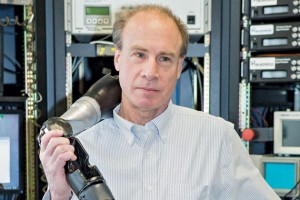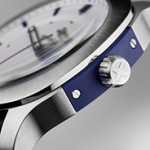Andrew Schwartz: Brain Control for Artificial Limbs
When Jan Scheuermann grasped a chocolate bar and raised it to her mouth last year, it was a neuroscience breakthrough. Scheuermann, who has lost the movement of her limbs due to a degenerative spinal condition, was piloting a mechanical arm connected to her brain, using her thoughts to replicate natural motion.

It was also a triumph for Andrew Schwartz, a neurophysiologist at the University of Pittsburgh, who’s spent three dec-ades mapping the connections between the brain and the body. Until the 1980s, scientists believed the brain interacted with limbs in a fairly rote, mechanical way: Certain neurons lit up when corresponding muscles moved. Schwartz was part of a Johns Hopkins University research team that found the brain was actually expressing an intentional behavior, like turning a doorknob, that he could read in the neuron’s electrical signals. “When you watch someone dancing … there’s a sort of beautiful coordination and precision and athleticism incorporated in the movement,” he says. “Those are the kinds of things we could find in this cortical activity.”
With that understanding, Schwartz’s team developed a prosthesis that could mimic complex motions. They implanted electrical sensors into Scheuermann’s brain—192 needles 1/15 of an inch long. These transmit information to software they developed to translate her thoughts into the motion of an arm that moves in three dimensions, with a wrist that turns and bends and fingers that clasp. By the second day, she could give Schwartz a high-five. In 13 weeks, Scheuermann had a degree of control that the scientist had expected would take a year to master.
Brain-connected prosthetics could reduce the effort patients need to make, says Ryan Blanck, a prosthetist at Brooke Army Medical Center in San Antonio who works with service members injured in Iraq and Afghanistan. “In the past, you had to do a lot of mental gymnastics to operate the prosthesis,” he says. Patients dislike them because they’re not intuitive.
Schwartz’s path to prosthetics came through a long-held interest in understanding spinal cord injuries. “Andy started out as a scientist. He came into this piece of it wanting to understand how the brain works,” says William Heetderks, a director of extramural science programs at the National Institutes of Health, which has funded some of Schwartz’s research. Over time, Heetderks says, Schwartz became committed to making the technology a viable therapy. “He was going to make this system work for rehabilitation,” he says.
Schwartz’s device is a long way from commercial availability. Among other challenges, the initial version requires a brain implant and a cord that connects the mechanical arm to the patient. Still, Schwartz says, the success of the trial shows “conclusively that this has true therapeutic value.” With each successful movement—picking up a ball, stacking cones, lifting a piece of food—he could tell Scheuermann, “nobody else in the world in recorded history has ever done this.”








